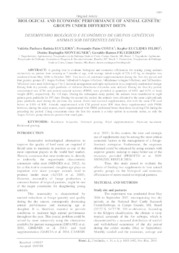Biological and economic performance of animal genetic groups under different diets.
Biological and economic performance of animal genetic groups under different diets.
Autoria: EUCLIDES, V. P. B.; COSTA, F. P.; EUCLIDES FILHO, K.; MONTAGNER, D. B.; FIGUEIREDO, G. R.
Resumo: A grazing trial to evaluate biological and economic efficiencies for rearing young animals exclusively on pasture from weaning at 7 months of age, with average initial weight of 220 ± 12 kg, to slaughter was conducted from May 2006 to October 2007. Two levels of combined supplementation during the first dry period and four genetic groups (F1 Angus-Nellore; ½Braford-¼Angus-¼Nellore; ½Brahman-¼Angus-¼Nellore; and Charolais- Nellore) were used following a 4 by 2 factorial arrangement and eight replications in a completely randomized design. During both dry periods, eight paddocks of deferred Brachiaria brizantha were utilized. During the first dry period, concentrated mix (CM) and protein-mineral mixture (PMM) were provided in quantities of 0.8% and 0.2% of body weight (BW), respectively, for 142 days. During the subsequent rainy period, the animals were transferred to eight guinea grass paddocks for 197 days. During the second dry period, the animals were allocated to the same eight palisade grass paddocks used during the previous dry season. Steers had received supplementary diet with the same CM used before at 0.8% of BW. Animals supplemented with CM gained more BW than those supplemented with PMM; however, during the rainy season, steers supplemented with PMM performed better than those receiving CM during the preceding dry period. Using concentrate since the first dry season is a risky option in economic terms, as only the Angus-Nellore group showed a positive but small gain.
Ano de publicação: 2018
Tipo de publicação: Artigo de periódico
Unidade: Embrapa Gado de Corte
Palavras-chave: Brachiaria Brizantha, Deferred grazing, Feed supplementation, Panicum Maximum, Rotational grazing
Observações
1 - Por padrão são exibidas publicações dos últimos 20 anos. Para encontrar publicações mais antigas, configure o filtro ano de publicação, colocando o ano a partir do qual você deseja encontrar publicações. O filtro está na coluna da esquerda na busca acima.
2 - Para ler algumas publicações da Embrapa (apenas as que estão em formato ePub), é necessário ter, no celular ou computador, um desses softwares gratuitos. Sistemas Android: Google Play Livros; IOS: iBooks; Windows e Linux: software Calibre.
Acesse outras publicações
Acesse a Base de Dados da Pesquisa Agropecuária (BDPA) para consultar o acervo completo das bibliotecas da Embrapa.

